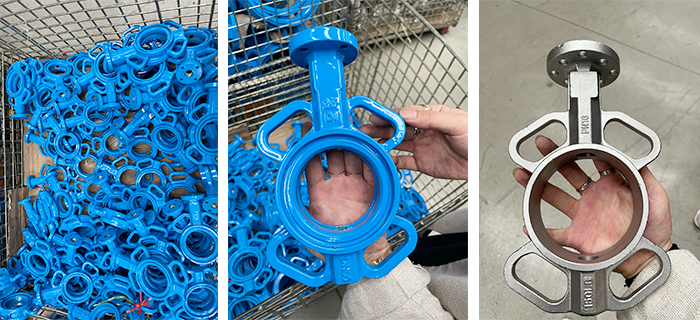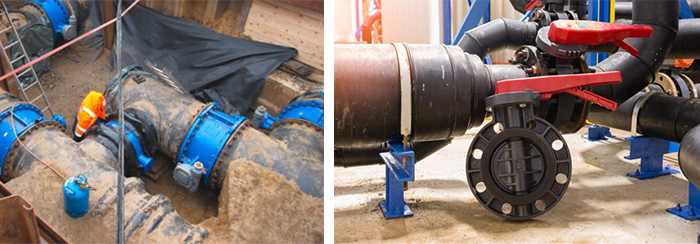- Gate valve
-
- DN1000 Extension stem double flange soft seal gate valveDIN F4 resilient seated gate valveDN450-1200 Resilient Seated Gate ValveDIN F5 resilient seated gate valveSocket connection soft seal gate valveUnderground cap soft seal gate valveBS5163 rising stem soft seal gate valveHard seal gate valveAPI slab Gate ValveStainless steel flange gate valveWafer knife gate valvePneumatic gate valveSoft seal gate valveExtension stem gate valveUL/FM fire protection groove ends gate valveRising stem forged steel gate valvecarbon steel gate valveStainless steel threaded gate valveDIN soft seal gate valveANSI soft sealing gate valve 200PSICast iron gate valveBS resilient seated gate valve
- Butterfly valve
-
- DN900 pneumatic triple eccentric hard seal butterfly valveD643H Triple Eccentric Butterfly ValveD343H Hard seal butterfly valveMulti standard EPDM seated butterfly valveSingle flange butterfly valveDN2000 Double eccentric butterfly valveFlange butterfly valveLug butterfly valveWafer butterfly valve with handleWorm gear operated butterfly valveWafer lined fluorine butterfly valveStainless steel wafer butterfly valveStainless steel flanged butterfly valveThree eccentric flange butterfly valvePneumatic flanged butterfly valvePneumatic wafer butterfly valveTriple eccentric butterfly valve wafer typeWafer butterfly valve ULC approvedInflatable seat butterfly valveHigh performance butterfly valveGrooved end butterfly valveElectric soft seal butterfly valveFlange fluorine lined butterfly valveHandle aluminum butterfly valveWorm Gear Aluminum Butterfly ValveFull PTFE lined butterfly valve wafer typeOne stem no-pin wafer butterfly valveMulti standard aluminum stem butterfly valveStainless Steel wafer Butterfly ValveAluminium handle operated lug butterfly valveLever Operated Flange Butterfly ValveButterfly valve stemButterfly valve discButterfly valve seat
- Ball valve
-
- DN1400 top-mounted eccentric semi-ball valveFlanged three-way ball valveFully welded ball valveNatural gas ball valveHigh platform flange ball valve1 PC ball valveFixed ball valvePTFE seat flanged ball valveMetal seat ball valveAPI 6D ball valve3 Piece ball valveFull Bore 3 way ball valve L-Port3 Way T-Port ball valve2PC Ball valve female thread stainless steel
- Globe Valve
-
- API Carbon Steel Globe ValveBellows Globe ValveStainless steel flange globe valveStainless steel thread S type globe valveStainless steel thread B type globe valveCast Steel Globe ValvePiston Globe ValveWCB Carbon Steel Globe Check Valveelectric motorized control stainless steel SS316 globe valveBrass Globe ValveCryogenic Globe valveHT200 Globe ValveThreaded Stainless Steel Globe ValveGG25 Globe ValveANSI API Cast Steel And Stainless Steel Globe valve
- Check valve
-
- Rubber seal check valveDN800 Slow closing check valveDN800 Rubber Disc Check ValveButterfly Buffering Check Valvecheck valve with counter weightSilent Check ValveWCB Swing check valveSwing Check ValveSingle Chip Check Valve H74WStainless Steel Wafer Check ValveSwing Start Check ValveFoot check valveAPI Swing Check ValveDIN Flange check valveSingle plate check valveLifting Check ValveBottom ValveHammer Diminish Noises Check ValveWafer Check ValveWafer dual plate check valve
- Control valve
-
- Static Balancing ValveCage Guided Sleeve Globe Control ValveDN1000 Piston Flow Regulating ValveDN1600 Electric Actuator Flow Regulating ValvePneumatic Flanged Butterfly ValvePneumatic Wafer Butterfly ValveAngle Seat ValvePneumatic gate valveElectric three-way control valveElectric sleeve control valve
- Water Meter
-
- Vertical Type Water MetersStainless steel threaded water meterPiston water meterPlastic water meterMore flow rotor dry water meterspiral vane flange water meterCI wotlman water meter with pulse outputLXCLG(R) Vertical removable element woltman cold (hot) water meterSingle flow rotor dry water meterPrepaid Token Water MeterElectromagnetic flowmeterRotary Piston Liquid Sealed Water MeterRotary Piston Liquid Sealed Water Meter
- Air valve
-
- Double ball exhaust valveDoubleair Air Valve SaudiDoubleair Air Valve Southeast AsiaDoubleair Air Valve South AmericaDouble Air ValveThreaded Air ValveSingle Air ValveTriple Functions Air ValveAutomatic Air Release ValveAutomatic release valveAutomatic exhaust valveComposite Exhaust Air ValveBrass exhaust valveDouble Ball Air Valve
- Pipe Repair & Coupling
-
- Flexible Multi-Function Pipe Coupling ZFJ-SSS Semi-Circle Pipe Repair Clamp SJW-HDuctile Iron Band Repair ClampStainless Steel Band Repair ClampDouble-Section Pipe Repair CouplingFolding Type Pipe RepairSingle-Section Multi-Function Pipe Coupling MF-SGear-Ring Type Multi-Function Pipe Coupling GR-SZBW Damping Corrugated Hose
- Dismantling Joint
-
- VSSJAFC(CC2F) Detachable Flange Transmission JointVSSJA-2(B2F) Double Flange Limited Expansion JointVSSJA-1(BF) Single Flange Limited Expansion JointVSSJA(AF) Flange Loose Expansion JointJGD-B Threaded Rubber JointZBW Damping Corrugated HoseKXT-S Flexible Dual-Spherical Rubber JointKXT Rubber Soft JointFlange Adaptor
What is a centerline butterfly valve?
What is a centerline butterfly valve?
Introduction of the centerline butterfly valve.
At present, the centerline butterfly valve as a component used to realize the pipeline system on-off and flow control has been extremely widely used in many fields such as petroleum, chemical industry, metallurgy, hydropower, and so on. In the known butterfly valve technology, its sealing form mostly uses a sealing structure, sealing material is rubber, PTFE, etc... Due to the limitations of structural features, it is not suitable for high-temperature resistance, high pressure and corrosion resistance, anti-wear, and other industries. A more advanced butterfly valve is a triple eccentric metal hard seal butterfly valve, the valve body and the valve seat for the conjoined components, seat sealing surface layer overlay welding temperature, and corrosion resistant alloy materials. The multi-layer soft stacked seal is fixed on the valve plate. Compared with the traditional butterfly valve, this butterfly valve has the advantages of high-temperature resistance, light operation, frictionless opening, and closing, and compensation sealing with the increase in torque of the transmission mechanism when closing, which improves the sealing performance and extends the service life of the butterfly valve.
Structural characteristics of the centerline butterfly valve.
The structural features of the centerline butterfly valve are the stem axis, butterfly plate center, and body center in the same position. The structure is simple and easy to manufacture. The common rubber-lined butterfly valve belongs to this category. The disadvantage is that the butterfly plate and the valve seat are always in the state of extrusion, scraping, large resistance distance, and fast wear. In order to overcome the extrusion, scraping, to ensure the sealing performance, the valve seat basically uses rubber or PTFE and other elastic materials, but also because the sealing materials in use temperature restrictions, which is why traditionally people think that the butterfly valve is not resistant to high-temperature reasons.
Features of the centerline butterfly valve.
1. Drive device flange
Can be used for the handle, gear operator, electric or pneumatic actuator.
2. Bushing
Reduces driving torque, supports the stem, and separates effectively from the valve body to reduce stem wear.
3. Disc shaft hole surface
Precise feet with the seat by polishing treatment.
4. High precision disc outer contour
Achieve airtightness requirements. Small start/stop torque and long seat life.
5. Valve stem seal
The valve stem is not easily deformed, eliminating the possibility of valve stem leakage.
6. Strong precision key
Provide possible attachments for manual lever or actuator.
7. Precision tapered pin
Ensures positive vibration resistance. Stem to disc connection. Easy field replacement.
8. One-piece stem design
High precision, good stability, and easy to start.
9. Side seal
No flange gasket is required.
10. Body-lined rubber seat
Good overall support, solid and firm, anti-stretch and anti-leakage.
11. O-ring
Prevent leakage at the shaft end.
Installation instructions for centerline butterfly valve.
Preparation work before installation.
1. Check whether the specification and material of the butterfly valve are in line with the design before installation.
2、And clean up the internal sand, dust, foreign matter, and debris before installation to avoid unpleasant action or leakage.
3、The relevant piping should be properly suspended and fixed according to the regulations before installation to avoid improper stress on the valve after installation.
4、The two flange surfaces of the piping must be aligned parallel and concentric.
5、No need to add a gasket between butterfly valve and flange during installation.
6、Where the butterfly valve is connected to the check valve or pump, use the expansion joint in the middle of the two so that the valve disc will not be obstructed by the twisting of the switch.
The valve disc will not be obstructed by twisting.
Installation steps.
1、Open the valve disc 10 degrees before installation. (The same before disassembly)
2、Set the auxiliary screw at the appropriate position to adjust the distance between the two flange surfaces.
3、Insert the butterfly valve without touching the two flange surfaces and put in the rest of the bolts.
4、After making sure that the center of butterfly valve is concentric with the center of the flange and the opening and closing position of the valve disc is not obstructed by the inner diameter of the flange or the adjacent machine, repeatedly lock the bolts in a diagonal and progressive manner until the flange surface touches the end of the valve body.
5、After the installation is completed, the full opening and full closing degree should be confirmed again.
Operation steps.
1、Before starting the operation, use air spray to clear the foreign matter on the pipeline and clean the inner surface of the pipeline with clean water.
2、Open the valve and check the angle indicator plate to avoid twisting more than the opening width and closing position.
3、The operation of the switch is completely based on the indicator, if other hand tools are used to apply force, the angle indicator plate and the switch will be damaged.
4、To do the piping pressure test, the valve should be opened.
5、After the piping, where it is in the full shutdown state for a long time, the switching action should be done 1~2 times a month to avoid the solidification condition.
Complete solutions for Industrial valves









